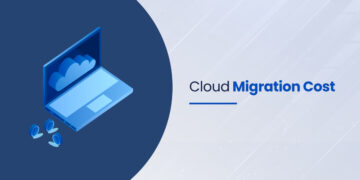Unlocking Value: Cloud Migration Costs and Savings
Moving enterprise infrastructure to the cloud—a process known as cloud migration—has become a strategic imperative, not just an IT project. Companies are driven by the promise of enhanced scalability, agility, and, crucially, significant cost savings. However, the path to the cloud is paved with initial expenses and complex financial planning. Achieving true value requires a meticulous understanding of both the upfront investment and the long-term economic advantages.
This comprehensive guide delves into the full financial spectrum of cloud migration, providing a framework for organizations to successfully navigate the complexities, optimize their spending, and maximize the return on investment (ROI). We’ll cover everything from the hidden expenses to the tangible savings that position the cloud as a powerful engine for modern business transformation.
Understanding the Initial Investment: Cloud Migration Costs
The cost of cloud migration is not monolithic; it’s a composite of various expenses that occur before, during, and immediately after the transition. Accurately modeling these costs is paramount for effective budget planning and securing executive buy-in.
A. Pre-Migration Assessment and Planning
Before a single workload moves, significant resources are dedicated to strategic planning. This phase, often underestimated, is critical for defining the scope and methodology of the migration.
- Consulting and Expertise: Many organizations lack the internal expertise for a massive cloud shift. This necessitates hiring external cloud architects or consultants to assess the current on-premises environment, define the target cloud architecture, and formulate a viable migration strategy (the “migration roadmap”).
- Total Cost of Ownership (TCO) Analysis: A detailed TCO study compares the current operational costs of the on-premises data center with the projected long-term costs of the cloud environment. This involves complex calculations for hardware depreciation, power consumption, real estate, labor, and new cloud consumption models.
- Tooling and Licensing: Investment in specialized migration tools, discovery software, and data transfer services is required. Additionally, current software licenses may need to be renegotiated or replaced to be compatible with cloud deployment models.
B. The Core Migration Expenses
These are the most direct and visible costs associated with physically moving data and applications.
- Data Egress/Transfer Costs: While cloud providers often waive or reduce the cost of ingressing (moving data to the cloud), the cost of transferring massive amounts of data from the on-premises data center to the cloud platform can be substantial. This is a one-time but potentially high-volume expense.
- Infrastructure Provisioning: The cost of setting up and running the new cloud infrastructure before the migration is complete. This includes running the cloud environment and the legacy systems simultaneously for a period, leading to a temporary “double-pay” scenario.
- Application Re-platforming or Re-architecting: Not all applications can be simply “lifted and shifted.” Applications may require extensive modification, or even a complete rewrite, to fully leverage cloud-native features. This deep engineering work is a major cost driver, demanding specialized developer resources.
C. Post-Migration Operational and Training Costs
After the technical migration is complete, new operational realities introduce new expenses.
- Workforce Training and Skilling: Cloud computing requires a different skill set. Existing IT staff must be trained in cloud architecture, security, cost management, and DevOps practices. This investment in human capital is vital for long-term success.
- Early Optimization Missteps: It’s common for organizations to initially over-provision cloud resources. Without proper Cloud FinOps (Financial Operations) practices in place from day one, unnecessary consumption can quickly inflate the initial cloud bill. This is less a migration cost and more an early operational inefficiency, but it dramatically impacts the immediate financial outlook.
- Security and Compliance Overheads: Implementing a robust cloud security posture, which differs significantly from on-premises security, requires investment in new tools, managed services, and ongoing compliance auditing to meet regulatory requirements (e.g., GDPR, HIPAA).
Deconstructing the Cloud Cost Model for Maximum AdSense Revenue
To ensure this long-form content performs exceptionally well for both readers and AdSense revenue, it’s essential to not just list costs but to deeply explain the mechanisms of cloud pricing, as this is a high-value, high-intent topic for technical decision-makers. The transition from CapEx (Capital Expenditure) to OpEx (Operational Expenditure) is the foundation of cloud finance.
D. The Shift from CapEx to OpEx
The most fundamental financial change in cloud migration is the move away from large, infrequent capital outlays to flexible, recurring operating expenses.
- CapEx (On-Premises): This involves large upfront purchases of servers, storage, networking gear, and data center space. These assets depreciate over time, and the infrastructure is typically refreshed every 3-5 years, leading to significant financial spikes.
- OpEx (Cloud): Cloud services are paid for on a consumption basis—pay-as-you-go. This means infrastructure costs are now variable, tied directly to usage (compute time, data stored, network traffic). This flexibility is a massive financial lever, but it demands rigorous monitoring.
E. The Key Consumption Vectors in Cloud Pricing
Understanding the big three—Compute, Storage, and Networking—is essential for predicting the cloud bill.
- Compute Costs: This is the hourly or per-second cost of virtual machines (VMs), containers, or serverless function execution. Pricing is determined by the size (vCPUs, RAM), operating system, and geographic region. The key is matching the compute size to the actual workload need, avoiding over-specifying resources.
- Storage Costs: Pricing is based on the volume of data stored (per GB/month) and the type of storage (e.g., high-performance SSD vs. archival cold storage). Intelligent tiering—automatically moving data to cheaper storage as its access frequency decreases—is a major optimization technique.
- Network (Data Transfer) Costs: These are the notorious Egress Charges—the cost of moving data out of the cloud provider’s network and into the public internet or another region. Ingress is generally free. Minimizing cross-region or internet-bound traffic is a core pillar of cost-saving.
 Achieving Substantial Financial Advantages: Cloud Savings
Achieving Substantial Financial Advantages: Cloud Savings
While initial costs can be daunting, the long-term cost savings and business value represent the primary justification for migration. These benefits extend far beyond simply shutting down a data center.
F. Elimination of Capital Expenditures
By far the most straightforward saving is the complete cessation of capital spending on physical hardware.
- No More Hardware Refresh Cycles: The significant, often disruptive, financial cycles associated with buying and installing new servers, racks, and cooling systems are entirely eliminated. Cloud providers handle all underlying infrastructure management.
- Reduction in Data Center Footprint: Eliminating the need for physical data centers frees up real estate, reduces astronomical utility bills (power and cooling), and removes the need for expensive physical security and maintenance contracts.
G. Optimization through Elasticity and Scaling
This is the central economic advantage of the cloud: paying only for what you use, and automatically scaling to meet demand.
- Rightsizing Resources: On-premises environments are typically provisioned for peak load, meaning a significant percentage of hardware is idle most of the time. In the cloud, autoscaling dynamically adjusts resources based on real-time traffic, ensuring you pay only for the compute capacity currently being utilized.
- Automation and Serverless: Adopting cloud-native services like serverless computing (e.g., AWS Lambda, Azure Functions) means paying only for the duration of code execution. This eliminates the cost of idle servers entirely, offering dramatic savings for event-driven or sporadic workloads.
- Consumption-Based Licensing: Cloud models often allow for pay-per-use software licensing, replacing expensive perpetual licenses and reducing vendor lock-in risk.
H. Productivity and Efficiency Gains
Savings are not limited to infrastructure; operational and personnel efficiencies contribute significantly to the ROI.
- Reduced Operational Overhead: Cloud providers handle tedious, undifferentiated heavy lifting, such as patching, hardware repair, disaster recovery planning, and capacity planning. This frees up in-house IT teams to focus on value-generating projects and innovation, rather than maintenance.
- Faster Time-to-Market: The cloud’s self-service provisioning and Infrastructure-as-Code (IaC) capabilities allow developers to spin up environments in minutes rather than weeks. This acceleration of the development lifecycle directly translates to faster feature delivery and revenue generation.
- Improved Disaster Recovery (DR) and Business Continuity: Implementing highly resilient, geo-redundant DR solutions is drastically cheaper and faster in the cloud than building a separate physical DR site. The reduced risk of downtime directly prevents costly business interruptions.
 Mastering Financial Operations (FinOps) for Sustained Savings
Mastering Financial Operations (FinOps) for Sustained Savings
Initial migration provides cost avoidance, but sustained cost reduction requires embedding a culture of FinOps. This is the ongoing discipline of bringing financial accountability to the variable cost model of the cloud.
I. Strategic Cost Optimization Levers
Successful companies employ specific strategies to continually reduce their monthly cloud bill.
- Reserved Instances (RIs) and Savings Plans (SPs): Committing to use a certain amount of computing power (e.g., specific VM type or compute usage) for a 1- or 3-year term unlocks discounts of up to 75% compared to on-demand pricing. This is ideal for stable, predictable workloads.
- Intelligent Storage Tiering: Automatically classifying and migrating data to the most cost-effective storage class (Hot, Cold, Archive) based on access patterns. This can cut storage costs by moving infrequently accessed data to deep archive tiers.
- Utilizing Spot Instances: Leveraging unused cloud capacity, which is offered at steep discounts (up to 90%). While these instances can be interrupted by the cloud provider, they are perfect for stateless, fault-tolerant, or batch processing workloads.
J. The Continuous Optimization Cycle
Cloud finance is not a one-time event; it’s a perpetual cycle of assessment and refinement.
A. Measure and Monitor: Implement robust Cost Management Tools to gain granular visibility into every dollar spent, associating spending with specific teams, projects, and applications. B. Analyze and Optimize: Review usage patterns for underutilized resources, identify instances that are consistently running 24/7 but could be turned off overnight, and look for opportunities to convert usage to Reserved Instances. C. Govern and Report: Establish clear policies and budgets, setting up alerts and guardrails to prevent cost overruns. Regular reporting to both finance and engineering teams ensures accountability and proactive cost awareness. D. Automate Remediation: Use automation tools to enforce policies, such as automatically shutting down unneeded development environments outside of business hours or downgrading storage tiers.
Conclusion
The decision to embark on cloud migration is complex, balancing a necessary initial capital outlay and temporary “double-pay” scenario against the prospect of profound, long-term financial and operational advantages. Success hinges on strategic planning, rigorous FinOps discipline, and a cultural commitment to agility.
The real return on investment in cloud migration transcends mere IT budget reduction. It is found in the business agility that allows for faster innovation, the scalability to handle explosive growth without infrastructure crises, and the operational efficiency that repurposes valuable engineering talent towards core business objectives. When executed correctly—with costs meticulously managed and savings diligently pursued—cloud migration becomes an indispensable catalyst for future revenue growth and market leadership. The initial investment is simply the price of admission to a perpetually optimized, flexible, and financially sound computing environment.







